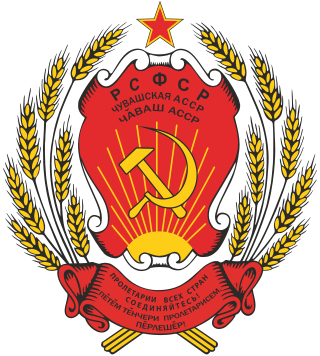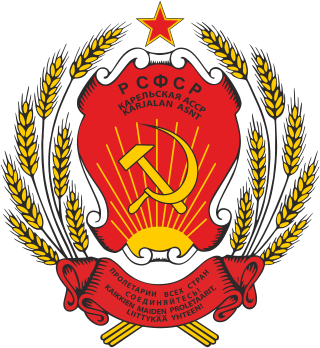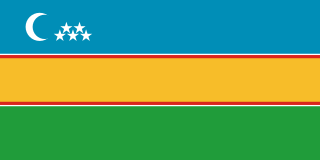
The Republics of the Union of Soviet Socialist Republics or the Union Republics were national-based administrative units of the Union of Soviet Socialist Republics (USSR). The Soviet Union was formed in 1922 by a treaty between the Soviet republics of Byelorussia, Russian SFSR (RSFSR), Transcaucasian Federation, and Ukraine, by which they became its constituent republics of the Union of Soviet Socialist Republics.
The flags of the Soviet Socialist Republics were all defaced versions of the flag of the Soviet Union, which featured a golden hammer and sickle and a gold-bordered red star on a red field.

The Turkestan Autonomous Soviet Socialist Republic, originally called the Turkestan Socialist Federative Republic, was an autonomous republic of the Russian Soviet Federative Socialist Republic located in Soviet Central Asia. Uzbeks were the preeminent nation of the Turkestan ASSR. Tashkent was the capital and largest city in the region.

The State Emblem of Tajikistan is a modified version of the original emblem of the Tajik Soviet Socialist Republic that was in use until the dissolution of the Soviet Union in 1991.

The emblem of Kazakhstan was adopted on 4 June 1992. The designers of the emblem are Jandarbek Melibekov and Shot-Aman Ualikhan. About 245 projects and 67 description designs of the future arms took part in the final competition. Like other post-Soviet republics whose symbols do not predate the October Revolution, the current emblem retains some components of the Soviet one, in this case, rising sun rays and star. Prior to 1992, Kazakhstan had an emblem similar to all other Soviet Republics.

Soviet Central Asia was the part of Central Asia administered by the Soviet Union between 1918 and 1991, when the Central Asian republics declared independence. It is nearly synonymous with Russian Turkestan in the Russian Empire. Soviet Central Asia went through many territorial divisions before the current borders were created in the 1920s and 1930s.

The coat of arms of the Kazakh Soviet Socialist Republic was adopted on March 26, 1937, by the government of the Kazakh Soviet Socialist Republic. The coat of arms is based on the coat of arms of the Soviet Union.

The Alash Autonomy, also known as Alash Orda, was an unrecognized Kazakh provisional government, or proto-state, located in Central Asia and was part of the Russian Republic, and then Soviet Russia. The Alash Autonomy was founded in 1917 by Kazakh elites, and disestablished after the Bolsheviks banned the ruling Alash party. The goal of the party was to obtain autonomy within Russia, and to form a national, democratic state. The political entity bordered Russian territories to the north and west, the Turkestan Autonomy to the south, and China to the east.

The Syr-Darya Oblast was one of the oblasts of the Russian Empire, a part of Russian Turkestan. Its center was Tashkent.

The national emblem of the Chuvash Autonomous Soviet Socialist Republic was adopted in 1937 by the government of the Chuvash Autonomous Soviet Socialist Republic. The emblem is identical to the emblem of the Russian Soviet Federative Socialist Republic.

The emblem of the Komi Autonomous Soviet Socialist Republic was adopted in 1938 by the government of the Komi Autonomous Soviet Socialist Republic. The emblem is identical to the emblem of the Russian Soviet Federative Socialist Republic.

The national emblem of the Karelian Autonomous Soviet Socialist Republic was adopted in 1937 by the government of the Karelian Autonomous Soviet Socialist Republic. The emblem is identical to the emblem of the Russian Soviet Federative Socialist Republic.

The national emblem of the Tuvan Autonomous Soviet Socialist Republic was adopted in 1962 by the government of the Tuvan Autonomous Soviet Socialist Republic. The emblem is identical to the emblem of the Russian Soviet Federative Socialist Republic.

The national emblem of the Volga German Autonomous Soviet Socialist Republic was adopted in 1937 by the government of the Volga German Autonomous Soviet Socialist Republic. The emblem is identical to the emblem of the Russian Soviet Federative Socialist Republic.

The national emblem of the Yakut Autonomous Soviet Socialist Republic was adopted in 1937 by the government of the Yakut Autonomous Soviet Socialist Republic. The emblem is identical to the emblem of the Russian Soviet Federative Socialist Republic.

The national emblem of the Dagestan Autonomous Soviet Socialist Republic was adopted in 1937 by the government of the Dagestan Autonomous Soviet Socialist Republic. The emblem is identical to the emblem of the Russian Soviet Federative Socialist Republic.

The national emblem of the Adjarian Autonomous Soviet Socialist Republic was adopted in 1922 by the government of the Adjarian Autonomous Soviet Socialist Republic. The emblem is identical to the emblem of the Georgian Soviet Socialist Republic.

The emblem of the Crimean Autonomous Soviet Socialist Republic was adopted in 1921 by the government of the Crimean Autonomous Soviet Socialist Republic. The emblem was similar to the emblem of the Russian Soviet Federative Socialist Republic.

The flag of the Karakalpak Autonomous Soviet Socialist Republic was adopted in 1954 by the government of the Karakalpak Autonomous Soviet Socialist Republic. The flag is nearly identical to the flag of the Uzbek Soviet Socialist Republic. The former Karakalpak ASSR had its own flag from 1934 to its dissolution in 1992, which developed similarly to that of the Uzbek SSR. Basic design of the flag was always a red cloth with inscription.

The flag of Karakalpakstan is one of the official symbols of Karakalpakstan, an autonomous republic within Uzbekistan. It was designed from a sketch by Karakalpak artist Zhollybai Izentaev. The flag is based on the flag of Uzbekistan.





















